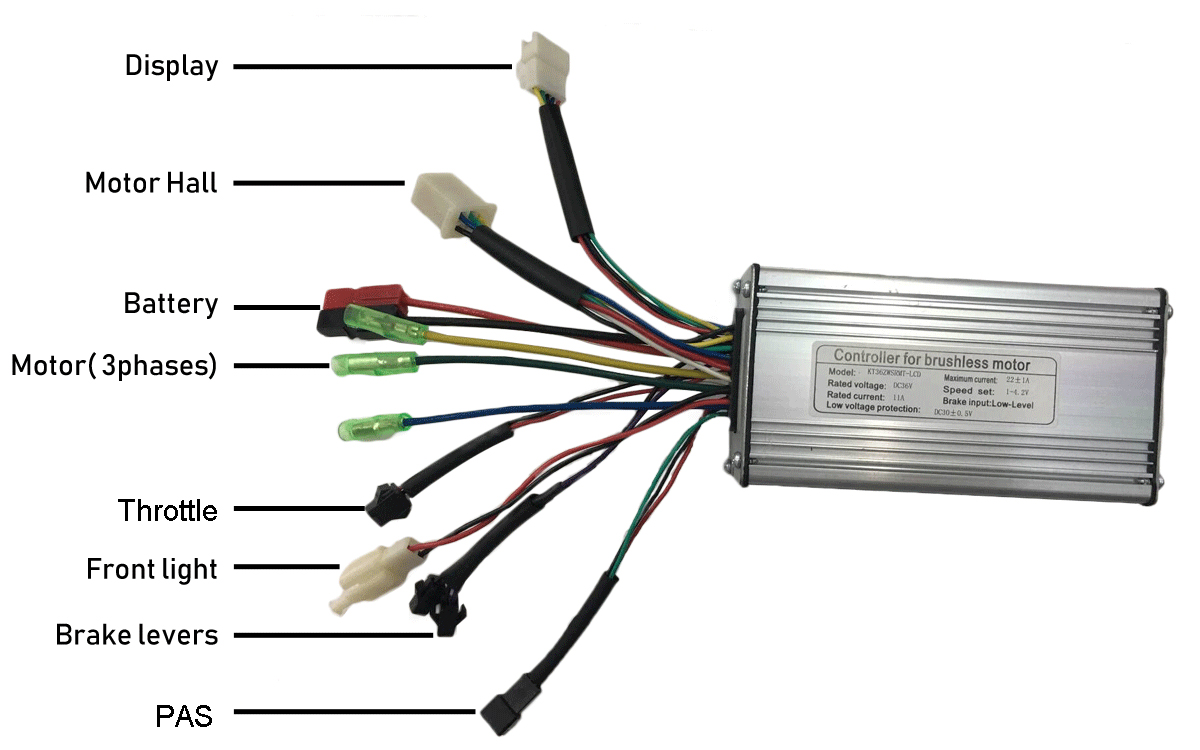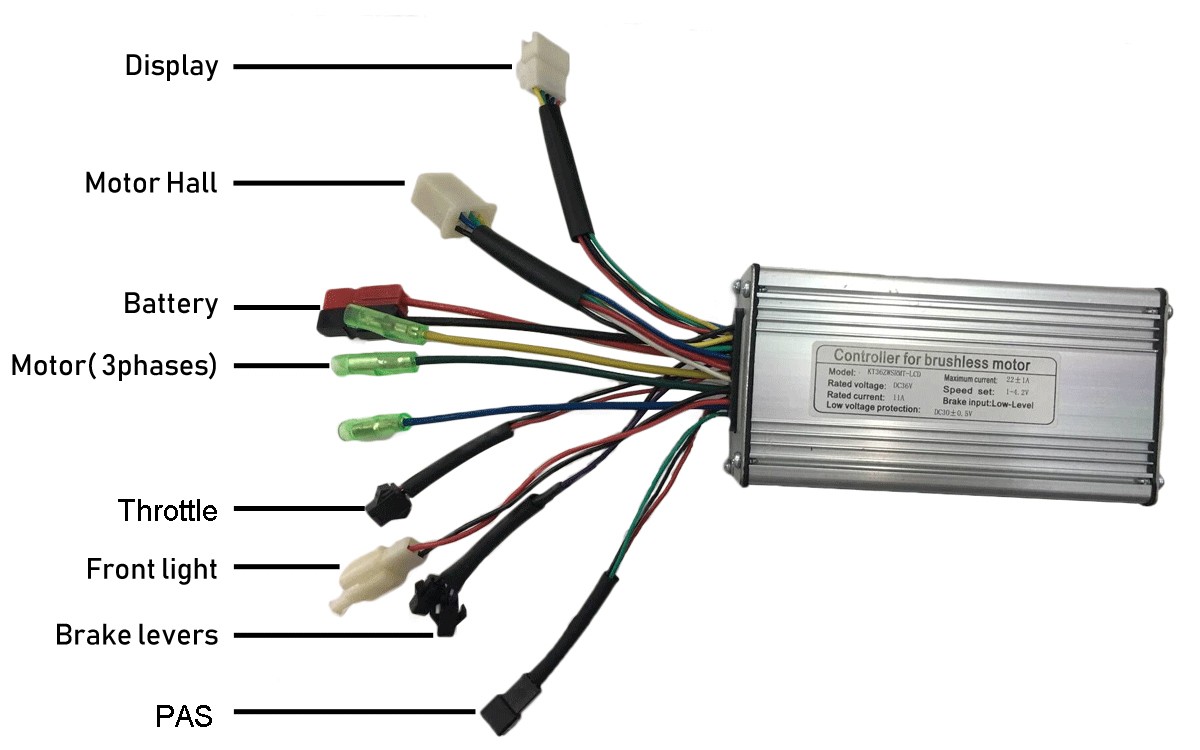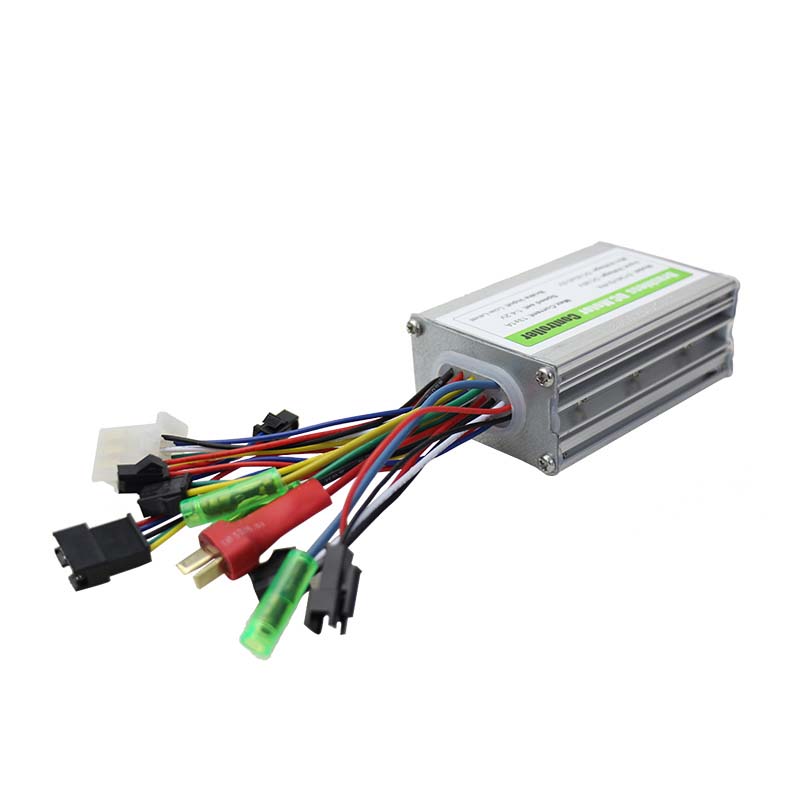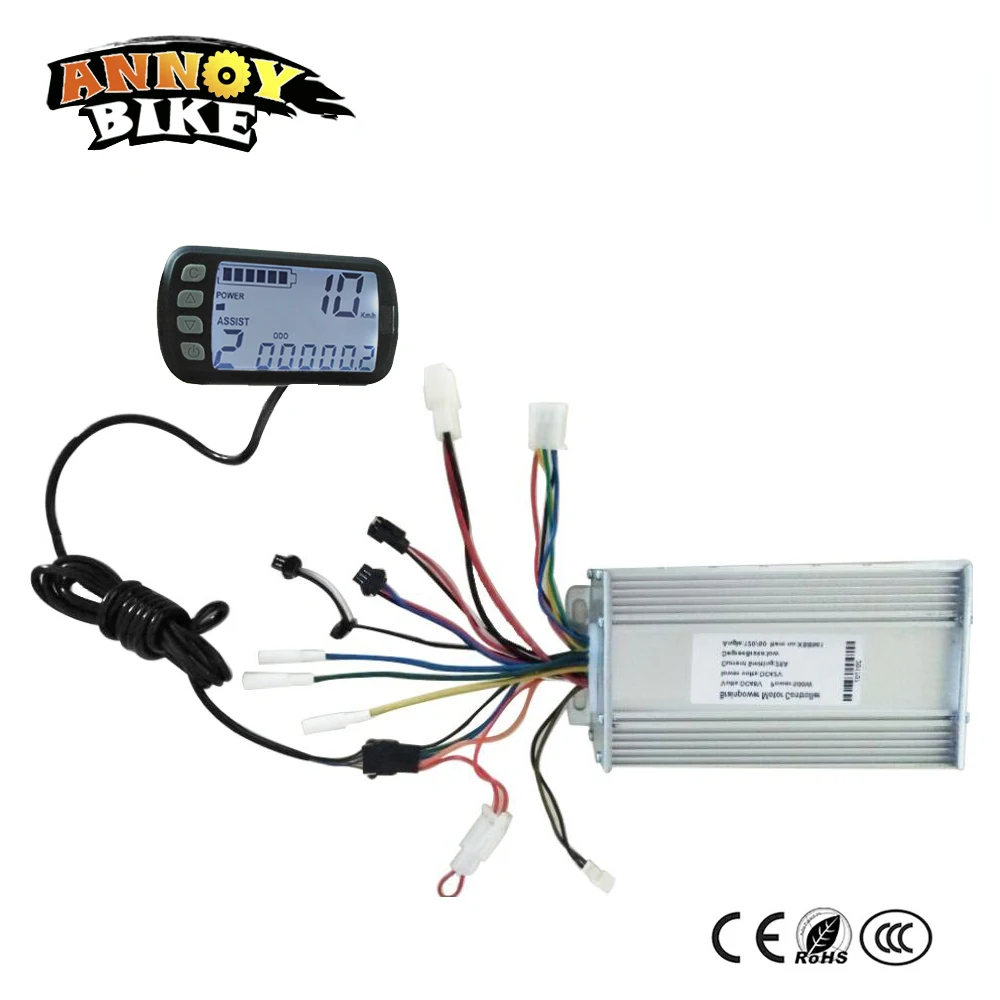What is an Electric Bike Controller?
An electric bike controller is a crucial component of an electric bike (e-bike) that manages and regulates the power output from the battery to the motor. It acts as the brain of the e-bike, controlling various functions such as speed, acceleration, and braking. Controllers come in different types, including cadence and torque sensors, and can be found in various models of e-bikes available in the market.
Key Components of an Electric Bike Controller
An electric bike controller is a complex system made up of various components that work together to manage and regulate the power output from the battery to the motor. Here are the key components of an electric bike controller:
User Interface
The user interface is the part of the controller that the rider interacts with, typically consisting of a display screen and buttons. The display screen shows important information such as speed, battery level, and pedal assist level, while the buttons allow the rider to change settings and control the bike’s functions.
Motor Controller
The motor controller is the heart of the electric bike controller, responsible for managing the power output to the motor. It receives signals from the pedal assist sensor and user interface, and adjusts the power output accordingly. The motor controller also monitors the battery level and ensures that the motor does not draw too much power, preventing damage to the battery and motor.
Pedal Assist Sensor
The pedal assist sensor (PAS) is a crucial component of the electric bike controller that detects the rider’s pedaling input and adjusts the power output from the motor accordingly. There are two main types of PAS: cadence sensors and torque sensors. Cadence sensors measure the frequency of the rider’s pedaling, while torque sensors measure the force applied to the pedals. Torque sensors provide a more natural and responsive riding experience, but are typically more expensive than cadence sensors.
Throttle
Some electric bikes come with a throttle, which allows the rider to control the power output of the motor directly, without pedaling. Throttles can be useful in certain situations, such as starting from a stop or going uphill, but they can also drain the battery quickly and are not allowed in some areas.
Battery
While not technically a part of the controller, the battery is a crucial component of the electric bike system. The controller manages the power output to the motor, but the battery provides the energy that the motor uses. Batteries come in various sizes and capacities, and choosing the right battery depends on factors such as range, weight, and cost.
Benefits of Upgrading Your Electric Bike Controller
Upgrading your electric bike controller can offer numerous benefits, such as improved performance, longer battery life, and better energy efficiency. Here are some real-life examples of electric bike controllers that offer these benefits:
Bafang Ultra Max
The Bafang Ultra Max is a popular electric bike controller that offers a range of benefits, such as improved torque and speed sensors, better heat dissipation, and a more intuitive user interface. It also features a Bluetooth connection, allowing riders to customize their settings and monitor their bike’s performance using a smartphone app.
Cyclone 3000W
The Cyclone 3000W is a high-powered electric bike controller that offers better energy efficiency and longer battery life. It features a sine wave controller, which provides smoother and more efficient power output, and a programmable interface, allowing riders to customize their settings and monitor their bike’s performance.
TSDZ2
The TSDZ2 is an affordable and customizable electric bike controller that offers improved performance and longer battery life. It features a torque sensor, which provides a more natural and responsive riding experience, and a programmable interface, allowing riders to customize their settings and monitor their bike’s performance.
Grin Technologies Cycle Analyst
The Grin Technologies Cycle Analyst is a versatile and customizable electric bike controller that offers better energy efficiency and longer battery life. It features a range of sensors and data displays, allowing riders to monitor their bike’s performance and customize their settings. It is also compatible with a range of batteries and motors, making it a popular choice for electric bike enthusiasts.
When choosing an electric bike controller, it is important to consider factors such as bike type, riding style, and budget. Popular electric bike controller brands include Bafang, Cyclone, TSDZ2, and Grin Technologies. It is also important to read reviews and do research to ensure that the controller is compatible with your bike and offers the features and benefits that you are looking for.
How to Choose the Right Electric Bike Controller
Choosing the right electric bike controller can be a daunting task, especially for those who are new to the world of electric bikes. However, by considering a few key factors, you can ensure that you choose a controller that meets your needs and enhances your riding experience. Here is a step-by-step guide on how to choose the right electric bike controller:
Step 1: Consider Your Bike Type
The first step in choosing the right electric bike controller is to consider the type of bike you have. Different bikes require different controllers, so it is important to choose a controller that is compatible with your bike. For example, if you have a hub motor bike, you will need a controller that is specifically designed for hub motors. If you have a mid-drive motor bike, you will need a controller that is specifically designed for mid-drive motors.
Step 2: Consider Your Riding Style
The second step in choosing the right electric bike controller is to consider your riding style. Do you prefer a leisurely ride, or do you enjoy pushing your bike to its limits? If you prefer a leisurely ride, you may want to choose a controller with a lower power output. If you enjoy pushing your bike to its limits, you may want to choose a controller with a higher power output. It is also important to consider the terrain you will be riding on. If you will be riding on hilly terrain, you may want to choose a controller with a higher power output to ensure that you have enough power to tackle the hills.
Step 3: Consider Your Budget
The third step in choosing the right electric bike controller is to consider your budget. Electric bike controllers can range in price from a few hundred dollars to several thousand dollars. It is important to choose a controller that fits within your budget, but also offers the features and benefits that you are looking for. Popular electric bike controller brands include Bafang, Cyclone, TSDZ2, and Grin Technologies. It is important to read reviews and do research to ensure that the controller you choose is compatible with your bike and offers the features and benefits that you are looking for.
Step 4: Consider the Features
The fourth step in choosing the right electric bike controller is to consider the features. Some controllers offer basic features, while others offer advanced features such as Bluetooth connectivity, programmable interfaces, and customizable settings. It is important to choose a controller that offers the features that you need and want. Some popular features include pedal assist sensors, throttles, and display screens.
Step 5: Consider the Installation
The fifth and final step in choosing the right electric bike controller is to consider the installation. Some controllers are easy to install, while others require more advanced skills. It is important to choose a controller that you feel comfortable installing, or to hire a professional to install it for you. Some tools and accessories that can make the installation process easier include wire strippers, crimping tools, and cable ties.
How to Install an Electric Bike Controller
Installing a new electric bike controller can seem like a daunting task, but with the right tools and knowledge, it can be a straightforward process. Here is a step-by-step guide on how to install an electric bike controller:
Step 1: Remove the Old Controller
The first step in installing a new electric bike controller is to remove the old one. Start by disconnecting the battery and unplugging the wires from the old controller. Then, unscrew the controller from the frame and remove it. Be sure to keep track of which wires go where, as you will need to reconnect them to the new controller.
Step 2: Prepare the New Controller
Once you have removed the old controller, prepare the new one by identifying the different terminals and connectors. Most electric bike controllers will have terminals for the throttle, pedal assist sensor, brake levers, and battery. Make sure that you have the correct wires and connectors for your specific controller.
Step 3: Connect the Wires
The next step is to connect the wires from the bike to the new controller. Start by connecting the battery wires, making sure to match the positive and negative terminals. Then, connect the throttle, pedal assist sensor, and brake lever wires. Be sure to tighten the connectors securely to prevent any loose connections.
Step 4: Mount the Controller
Once you have connected all the wires, mount the new controller to the frame using the screws provided. Make sure that it is securely fastened and that the wires are not stretched or pinched.
Step 5: Test the Controller
The final step is to test the new controller to make sure that it is working properly. Reconnect the battery and turn on the controller. Test the throttle, pedal assist sensor, and brakes to make sure that they are responding correctly. If everything is working properly, you are ready to ride.
Safety Precautions
When installing a new electric bike controller, it is important to take safety precautions to prevent any accidents or injuries. Always disconnect the battery before working on the controller. Make sure that the controller is securely mounted and that the wires are not loose or damaged. If you are not comfortable installing the controller yourself, consider hiring a professional to do it for you.
Troubleshooting Tips
If you are having trouble installing the new controller, here are some troubleshooting tips to help you:
- Check the wiring connections to make sure that they are secure.
- Make sure that the controller is compatible with your bike and battery.
- Check the voltage and amperage ratings of the controller to make sure that they match your battery and motor.
- Consult the controller’s manual or contact the manufacturer for technical support.
Tools and Accessories
Here are some tools and accessories that can make the installation process easier:
- Wire strippers and crimping tools
- Multimeter for testing voltage and resistance
- Heat shrink tubing for insulating and protecting wires
- Zip ties for organizing and securing wires
Maintenance Tips for Electric Bike Controllers
Just like any other electronic device, electric bike controllers require regular maintenance to ensure optimal performance and longevity. Here are some maintenance tips for electric bike controllers:
Clean the Controller Regularly
Dirt, dust, and debris can accumulate on the controller over time, which can affect its performance. Use a soft, dry cloth to gently wipe the controller and remove any dirt or debris. Avoid using water or any cleaning solvents, as they can damage the controller.
Check the Wiring Connections
Loose or damaged wiring connections can cause issues with the controller. Check the wiring connections regularly to ensure that they are secure and not damaged. If you notice any frayed or damaged wires, replace them immediately.
Update the Firmware
Manufacturers often release firmware updates for their electric bike controllers to improve performance, fix bugs, and add new features. Check the manufacturer’s website regularly for firmware updates and follow the instructions to update the controller.
Store the Controller Properly
When not in use, store the controller in a dry, cool place to prevent any damage from moisture or heat. Avoid exposing the controller to extreme temperatures, as they can affect its performance and longevity.
Common Issues and How to Fix Them
Here are some common issues that can arise with electric bike controllers and how to fix them:
- Controller not responding: Check the wiring connections and make sure that the controller is properly connected to the battery and motor. If the connections are secure and the controller is still not responding, try resetting the controller.
- Erratic behavior: If the controller is behaving erratically, such as suddenly increasing or decreasing speed, check the wiring connections and make sure that the controller is not damaged. If the connections are secure and the controller is not damaged, try resetting the controller.
- Overheating: If the controller is overheating, it may be due to excessive use or exposure to heat. Allow the controller to cool down before using it again. If the overheating persists, check the wiring connections and make sure that the controller is not damaged. If the connections are secure and the controller is not damaged, try reducing the power output or using the controller in cooler temperatures.
Conclusion
Regular maintenance is essential for ensuring the optimal performance and longevity of electric bike controllers. By cleaning the controller regularly, checking the wiring connections, updating the firmware, and storing the controller properly, you can prevent common issues and ensure that your electric bike controller performs at its best. If you do encounter any issues with your electric bike controller, follow the troubleshooting tips outlined above to diagnose and fix the problem.
The Future of Electric Bike Controllers
Electric bike controllers have come a long way since their inception, and the future looks promising for even more advancements. Here are some developments to look out for in the world of electric bike controllers:
Integration with Smartphones
As smartphones become increasingly integrated with our daily lives, it’s no surprise that they are making their way into the electric bike world as well. Some electric bike controllers are already compatible with smartphones, allowing riders to track their speed, distance, and battery life, as well as customize their riding experience. In the future, we can expect even more advanced integration, such as the ability to control the bike’s settings and diagnostic information directly from a smartphone app.
Voice Control
Voice control technology is becoming increasingly popular in various industries, and the electric bike industry is no exception. Imagine being able to control your electric bike’s speed, power, and settings with just your voice. This technology is still in its early stages, but it has the potential to revolutionize the way we ride electric bikes.
Regenerative Braking
Regenerative braking is a technology that allows electric bikes to convert kinetic energy into electrical energy, which can then be used to recharge the battery. This technology is already available in some electric bikes, but it is expected to become more widespread in the future. Regenerative braking not only helps to extend the battery life but also reduces the wear and tear on the brakes, making for a more efficient and eco-friendly ride.
Companies Leading the Way
There are several companies that are leading the way in electric bike controller technology. Some of these companies include Bafang, Bosch, Brose, and Yamaha. These companies are constantly pushing the boundaries of what’s possible with electric bike controllers, incorporating innovative features and technologies to enhance the riding experience.
Conclusion
The future of electric bike controllers is exciting, with advancements in smartphone integration, voice control, and regenerative braking. By staying up-to-date with the latest developments in electric bike controller technology, riders can enjoy a more efficient, eco-friendly, and enjoyable riding experience. Whether you’re a seasoned electric bike rider or just starting out, it’s worth exploring the different features and benefits of electric bike controllers to make the most of your riding experience.
Conclusion: Making the Most of Your Electric Bike Controller
Electric bike controllers play a crucial role in the overall functioning of electric bikes, controlling the speed and power of the bike. By understanding the different types of controllers available in the market, their key components, and the benefits of upgrading, riders can make informed decisions when choosing the right controller for their needs.
When choosing an electric bike controller, it’s important to consider factors such as bike type, riding style, and budget. Popular electric bike controller brands such as Bafang, Bosch, and Brose offer a range of features and benefits, from improved performance to better energy efficiency.
Installing and maintaining an electric bike controller requires some technical knowledge, but with the right tools and resources, it can be a straightforward process. Regular maintenance, such as cleaning the controller, checking the wiring connections, and updating the firmware, can help ensure the longevity and efficiency of the controller.
The future of electric bike controllers is exciting, with advancements in smartphone integration, voice control, and regenerative braking. By staying up-to-date with the latest developments in electric bike controller technology, riders can enjoy a more efficient, eco-friendly, and enjoyable riding experience.
For further reading and learning, we recommend checking out resources such as electric bike forums, manufacturer websites, and online retailers. These resources can provide valuable insights and information on the latest electric bike controller technology, as well as tips and tricks for installation and maintenance.
Overall, taking the time to understand and choose the right electric bike controller can make a significant difference in the performance and enjoyment of your electric bike. With the right controller, riders can experience improved speed, power, and efficiency, making their electric bike rides more enjoyable and eco-friendly.







